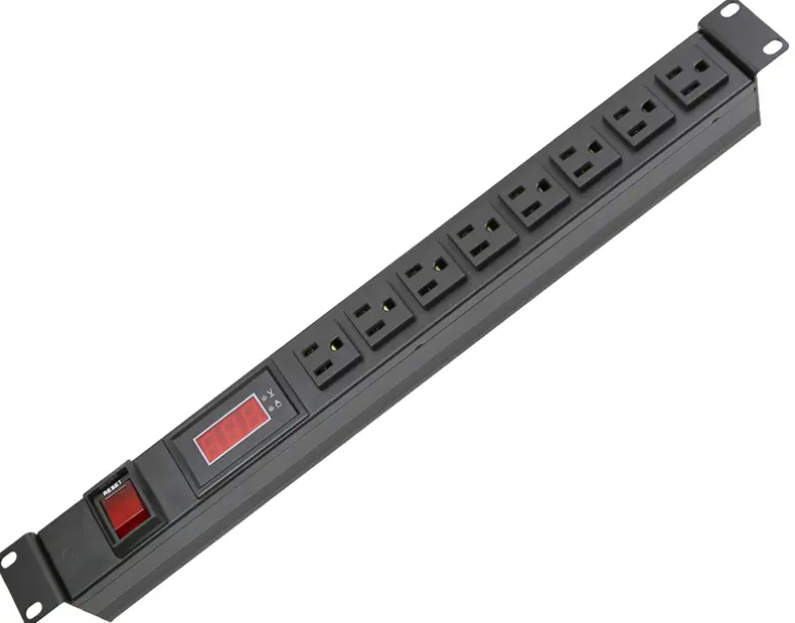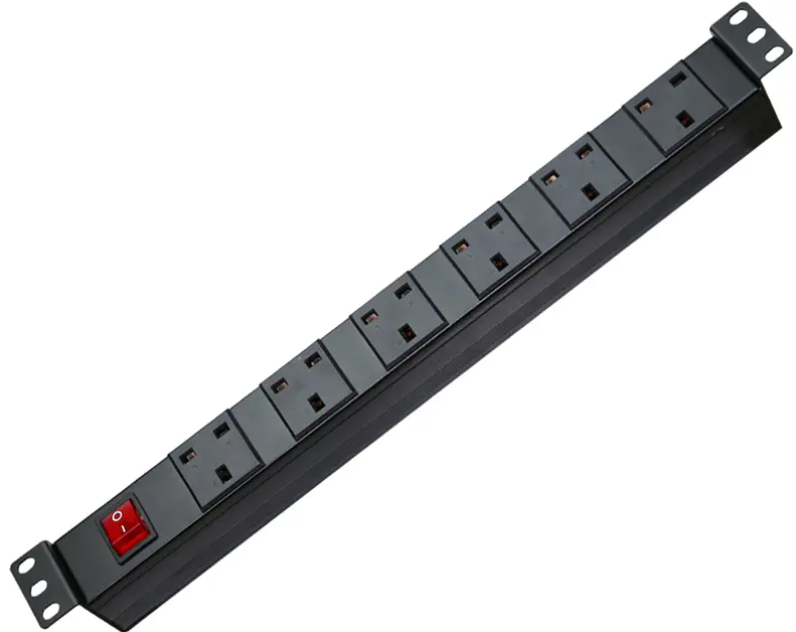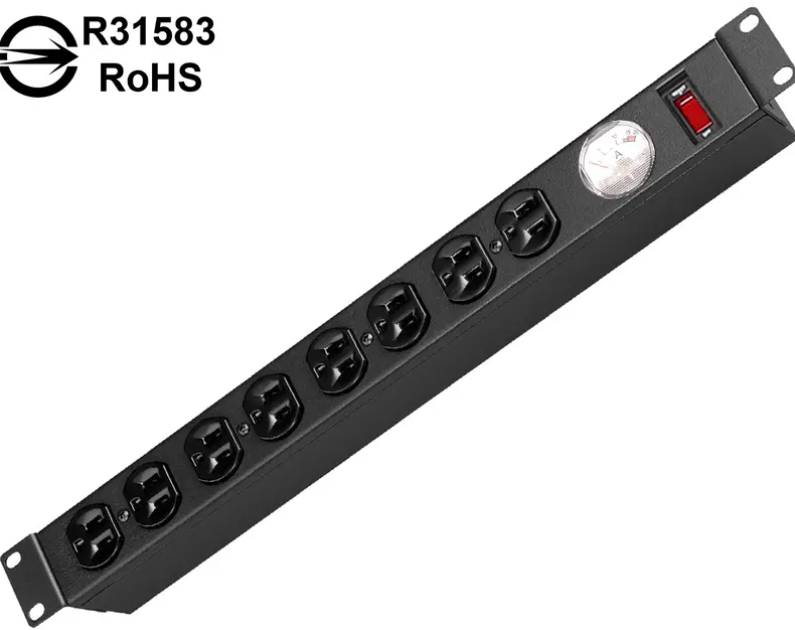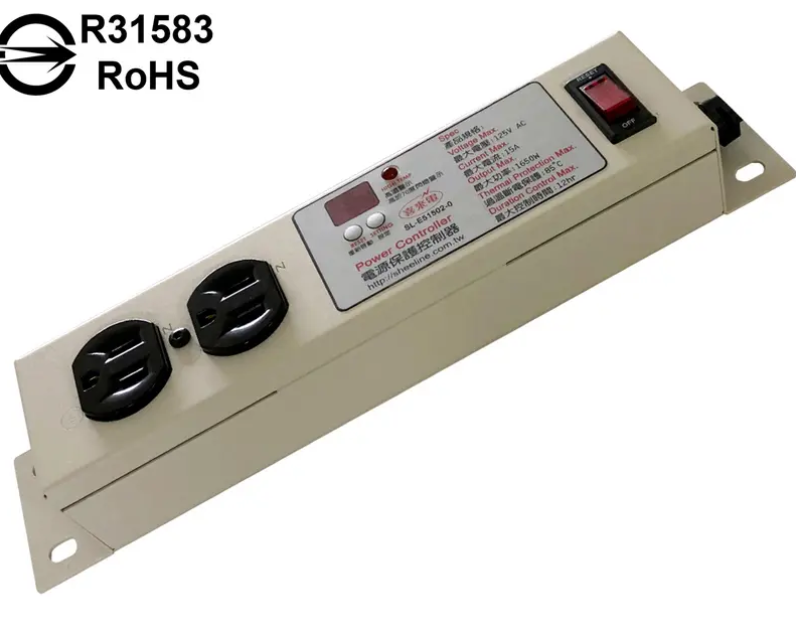- All
- Product Name
- Product Keyword
- Product Model
- Product Summary
- Product Description
- Multi Field Search
Views: 0 Author: Site Editor Publish Time: 2025-09-19 Origin: Site

Are you struggling with managing power in your server rack? Discover how a 19" Rack-Mount Power Distribution Unit (PDU) can solve your problems. PDUs are essential for efficient power distribution in server racks. In this post, you'll learn what a 19" Rack-Mount PDU is, why it's crucial, and explore various types to find the perfect fit for your needs.
Selecting the right power distribution unit (PDU) for your 19" rack is crucial for reliable and efficient power management. Here are the key factors to consider to ensure your rack power unit meets both current and future needs.
Start by calculating the total power consumption of all devices in your rack. Check each device's power rating—usually listed in watts or volt-amps—and sum them up. It's wise to choose a rack mount power distribution panel with a capacity that exceeds this total by at least 20% to allow for future expansion and prevent overloads. Remember, in North America, PDUs are typically rated for 120V or 208/240V, while other regions may use 230V. Also, consider whether your rack uses single-phase or three-phase power. Three-phase PDUs are ideal for high-density environments requiring efficient power distribution.
Your choice between horizontal and vertical mounting affects space and outlet count. Horizontal PDUs fit within the rack's 1U or 2U space and usually offer fewer outlets. They're suitable for smaller racks or setups with lower power needs. Vertical PDUs, often called 0U PDUs, mount along the rack's vertical rails, saving valuable rack space while providing up to 40 or more outlets. This is ideal for high-density racks. Vertical PDUs also improve cable management and airflow. Consider your rack size, equipment density, and airflow requirements before deciding.

Ensure your PDU's input voltage matches your facility's power source. Mismatched voltage can cause equipment failure or safety hazards. Also, verify the outlet types on the PDU correspond to your equipment plugs. Common outlet types include IEC-320-C13 and IEC-320-C19 for servers and networking gear, and regional variants like NEMA 5-15R or Schuko sockets. Some rack mount PDUs offer mixed outlet configurations to support diverse equipment. Matching outlet types simplifies installation and reduces the need for adapters.
Select a rack mountable power distribution unit with more outlets than your current devices require. This helps accommodate new equipment without replacing the PDU. For growing data centers, vertical PDUs with high outlet counts are advantageous. Additionally, consider PDUs with individual outlet switches or remote control features, allowing you to manage power to each device independently. This flexibility supports efficient maintenance and reduces downtime.
Modern rack switched PDUs come with advanced features like remote monitoring and management via network interfaces. These allow IT staff to monitor power usage, environmental conditions, and control outlets remotely. Features such as automatic device reboot, load balancing, and environmental sensor integration enhance uptime and simplify management. If your setup requires high availability or is distributed across multiple locations, investing in a network rack PDU with these capabilities is beneficial.
Choosing the right type of power distribution unit (PDU) for your 19" rack is essential. Each type offers different features and benefits tailored to specific needs. Let's explore the common types of rack mounted power distribution units so you can find the best fit for your setup.
Basic PDUs provide straightforward power distribution without monitoring or remote control. They're often called “dumb” PDUs because they simply deliver power to multiple outlets. These rack mount power distribution panels are ideal for small server rooms or offices where simplicity and cost-effectiveness matter most. Basic PDUs come in horizontal and vertical formats, with outlet counts ranging from 8 to 24. While they lack advanced features, they reliably power your devices and often include circuit breakers for overload protection.
Metered PDUs add local power monitoring to the basic design. They feature digital load meters that display real-time current draw, usually in amps. This helps you balance power loads and avoid overloads. Some models provide multiple meters for different load banks. Metered PDUs are great when you want to keep an eye on power usage without remote network access. They provide a simple way to gain visibility into your rack's power consumption.
Monitored PDUs, sometimes called smart PDUs, include all metered features plus network connectivity. They allow remote monitoring of power usage and environmental conditions through a network rack PDU interface. This means you can check voltage, current, and temperature from anywhere, improving management efficiency. Alerts notify you if power thresholds are exceeded, helping prevent downtime. Monitored PDUs are well suited for data centers and critical IT environments requiring proactive maintenance.
Switched PDUs build on monitored units by adding remote control capabilities. You can turn individual outlets on or off via a web interface or network management software. This rack switched PDU feature enables remote rebooting of devices, reducing the need for on-site visits. Switched PDUs often include rack mount PDUs with individual switches for granular control. They're perfect for distributed IT environments, branch offices, or locations without dedicated IT staff.
ATS PDUs provide automatic power source redundancy for single-corded devices. They connect to two separate power inputs and switch to the backup source if the primary fails. This ensures continuous power without interruption. Auto transfer switch PDUs are valuable in telecom racks or legacy systems where uptime is critical but equipment lacks dual power supplies.
Hot-swap PDUs feature dual AC inputs and a manual transfer switch. They allow maintenance or replacement of UPS systems without powering down connected equipment. This rack mountable power distribution unit type supports zero downtime during service, making it ideal for mission-critical environments requiring continuous operation.
Tip: For high-density racks, consider a rack vertical PDU with remote monitoring and switched outlets to maximize space and control while ensuring power reliability.

Installing a 19" rack-mount power distribution unit correctly ensures your server rack operates efficiently and safely. This section covers preparation, safe installation steps, and cable management best practices to help you maximize your rack power distro's reliability.
Before installing your rack mount power distribution panel, take time to prepare the server cabinet:
● Verify Dimensions and Mounting Type: Measure your rack's height, width, and depth to confirm the PDU fits, whether horizontal (1U or 2U) or vertical (0U rack vertical PDU). Vertical PDUs save space but require mounting rails or brackets compatible with your rack.
● Assess Power Needs: Double-check your power distribution unit's voltage, amperage, and outlet types match your equipment and power source. Ensure the PDU supports single-phase or three-phase power as required.
● Gather Tools and Hardware: Have screwdrivers, mounting brackets, screws, cable ties, and labels ready. Some rack mountable PDUs come with reversible mounting ears or toolless brackets for easier installation.
● Plan Cable Management: Organize and label power cords ahead of time. Plan routes to avoid blocking airflow or creating clutter. Separate power cords from data cables to minimize interference.
● Safety First: Always power down the rack and use insulated gloves and eye protection before handling electrical equipment.
Follow these steps to install your rack power distribution unit safely and effectively:
1. Mount the PDU: Attach the PDU securely using the provided brackets or mounting ears. For vertical PDUs, snap or screw the unit onto the rack's vertical rails. For horizontal PDUs, install in a 1U or 2U space, choosing front or rear orientation based on outlet access.
2. Connect Power Input: Plug the PDU into your power source, ensuring the plug type and voltage match. Use heavy-duty cords rated for your power load.
3. Distribute Power to Devices: Connect your servers, switches, and other equipment to the PDU outlets. If using a rack mount pdu with individual switches or a rack switched PDU, label outlets for easy identification.
4. Check Load Balancing: Distribute devices across outlets to balance power draw and avoid overloads. Monitor load if your PDU supports metering or remote management.
5. Test the Setup: Power on the PDU and connected devices, verifying all equipment receives power and the PDU operates without faults.
Effective cable management in your rack power distro setup improves airflow, maintenance, and safety:
● Use Cable Managers and Velcro Ties: Secure cables neatly along rack rails or cable bars. Avoid zip ties that can damage cords.
● Label Each Cable: Mark both ends of every power cord with device and outlet information for quick troubleshooting.
● Keep Power and Data Cables Separate: This reduces electromagnetic interference and improves network performance.
● Maintain Airflow: Route cables to prevent blocking ventilation holes or fans. Use blanking panels and perforated doors to enhance cooling.
● Leave Slack for Maintenance: Avoid tight bends or tension on cords. Leave enough length to unplug or move devices without strain.
Tip: When installing a rack mountable power distribution unit, always plan cable routes and outlet assignments beforehand to simplify future maintenance and reduce downtime.
Modern rack power distribution units (PDUs) have evolved far beyond simple power strips. They now offer advanced features that enhance control, monitoring, and safety in your server rack. Understanding these capabilities helps you choose a rack mountable power distribution unit that fits your operational needs and streamlines management.
One of the most valuable features of a network rack PDU is remote monitoring and management. These PDUs connect to your IT network, allowing administrators to:
● View real-time power consumption per outlet or for the entire unit
● Monitor voltage, current, and power factor remotely
● Receive alerts for overloads, outages, or abnormal conditions
● Control power outlets individually, turning devices on or off without physical access
This remote access reduces the need for onsite visits, saving time and lowering costs. For example, a rack switched PDU with individual outlet control lets you reboot a hung server remotely, minimizing downtime. Many PDUs offer web interfaces or integrate with data center infrastructure management (DCIM) software for centralized control.
Modern PDUs often include or support environmental sensors that track conditions inside the rack. These sensors measure:
● Temperature and humidity levels
● Airflow and cooling efficiency
● Door open/close status or security alarms
Integrating environmental monitoring with your rack power distro enables proactive management. You can receive alerts before temperature spikes cause hardware failures or before humidity leads to condensation and corrosion. This feature is especially important in high-density racks where heat buildup is a concern.
Some intelligent PDUs feature automatic device reboot capabilities. Using built-in network probes, the PDU can ping critical devices periodically. If a device becomes unresponsive, the PDU automatically power cycles its outlet to reboot it. This automation prevents prolonged outages and reduces the need for manual intervention.
Load balancing features help distribute power evenly across phases or circuits. By monitoring current draw on each outlet or bank, the PDU can alert you to uneven loads that risk tripping breakers. Proper load balancing improves power efficiency and extends equipment life.
Tip: When selecting a rack mountable power distribution unit, prioritize models with remote monitoring and environmental sensors to enhance uptime and simplify management across your IT infrastructure.

When selecting a 19" rack-mount power distribution unit, safety and compliance are paramount. A reliable rack power distribution unit not only delivers power efficiently but also protects your equipment and personnel from electrical hazards. Let's explore the key safety aspects to consider.
Certified PDUs meet industry standards for safety and performance. Look for these common certifications:
● UL (Underwriters Laboratories): Ensures electrical safety and fire resistance, primarily for North America.
● CE (Conformité Européenne): Indicates compliance with European health, safety, and environmental requirements.
● CSA (Canadian Standards Association): Validates safety standards in Canada.
● RoHS (Restriction of Hazardous Substances): Confirms that hazardous materials are minimized, promoting environmental safety.
● ISO 9001: Reflects quality management systems ensuring consistent product quality.
● CCC (China Compulsory Certificate): Required for products sold in China, ensuring safety and quality.
● VDE/GS: German certifications for electrical safety and quality.
Choosing a rack mountable power distribution unit with these certifications guarantees adherence to global safety norms, reducing risks in your server environment.
Overload protection is critical to prevent damage caused by excessive current flow. Most rack mount PDUs include:
● Circuit Breakers: Automatically trip when current exceeds safe limits, cutting power to prevent equipment damage or fire.
● Thermal Protection: Detects overheating and shuts down the unit before damage occurs.
● Resettable Breakers: Allow quick restoration without replacing fuses, minimizing downtime.
● Load Monitoring: Advanced PDUs alert you when power draw approaches maximum capacity, enabling proactive load balancing.
These mechanisms safeguard your rack power distro from faults, ensuring continuous operation and protecting valuable IT assets.
The materials and design of your rack power distribution panel contribute to fire prevention and electrical safety:
● Flame-Retardant Housing: Metal or certified plastic enclosures resist ignition and contain potential fires.
● Proper Grounding: Essential for safe operation, grounding prevents electrical shock and equipment damage.
● Surge Protection: While many PDUs rely on upstream UPS units for surge protection, some models integrate surge suppressors to shield connected devices.
● Compliance with Local Electrical Codes: Ensure your PDU installation meets regional electrical standards and regulations.
Adhering to these standards reduces risks of electrical fires and hazards, protecting your data center and personnel.
When selecting a 19" rack-mount PDU, consider power requirements, installation type, voltage compatibility, and outlet types. Ensure your choice supports future expansion and offers remote management features. Look for safety certifications and overload protection to safeguard your equipment. For future-proofing, choose a PDU with flexibility and advanced features to adapt to evolving needs. Sheeline offers reliable PDUs that provide efficient power management and enhance operational efficiency, ensuring your data center remains robust and scalable.
A: Consider power requirements, installation type (horizontal vs. vertical), voltage compatibility, outlet types, and future expansion needs. Features like remote management can enhance efficiency.
A: It allows independent control of each outlet, enabling you to manage power distribution more effectively and reduce downtime by rebooting devices remotely.
A: Mismatched voltage can lead to equipment failure or safety hazards, so ensure your PDU's voltage matches your facility's power source for safe operation
Blog
